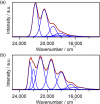Ligand triplet energy escape in lanthanide complexes for developing luminescent molecular thermometers
- PMID: 40890469
- PMCID: PMC12402069
- DOI: 10.1038/s42004-025-01673-1
Ligand triplet energy escape in lanthanide complexes for developing luminescent molecular thermometers
Abstract
Luminescent lanthanide complexes can exhibit temperature-sensitive metal-centered emission due to energy transfer quenching from the lanthanide to the ligand triplet states, which have been promising application in emission lifetime-based thermometers. However, the long-lived ligand triplet state limits the temperature sensitivity of lanthanide emission. This study demonstrates an enhancement in the temperature sensitivity of Tb(III) emission by introducing an energy escape pathway from the ligand triplet state. A dinuclear Tb(III)-Nd(III) complex containing hexafluoroacetylacetonate (hfa) and triphenylene bridging ligands was prepared, which exhibits temperature-dependent energy transfer from the Tb(III)-emitting state to the hfa triplet state. The triplet level of the hfa ligand is similar to that of the triphenylene ligand, inducing effective energy transfer from hfa to Nd(III) via the triphenylene ligands. This energy transfer pathway provides a short-lived excited state of hfa ligands, resulting in the highest temperature sensitivity (4.4% K-1) among emission lifetime-based thermometers of lanthanide complexes.
© 2025. The Author(s).
Conflict of interest statement
Competing interests: The authors declare no competing interests.
Figures








Similar articles
-
Prescription of Controlled Substances: Benefits and Risks.2025 Jul 6. In: StatPearls [Internet]. Treasure Island (FL): StatPearls Publishing; 2025 Jan–. 2025 Jul 6. In: StatPearls [Internet]. Treasure Island (FL): StatPearls Publishing; 2025 Jan–. PMID: 30726003 Free Books & Documents.
-
Triplet states nurture the long-lived emission at room temperature of a chlorine-containing tetraphenylimidazole derivative when aggregation occurs in water/acetonitrile mixtures.Photochem Photobiol. 2025 Jul-Aug;101(4):1027-1038. doi: 10.1111/php.14096. Epub 2025 Apr 1. Photochem Photobiol. 2025. PMID: 40165625
-
Dynamic Molecular Triplet Excitons Tune Lanthanide Emission Lifetime.Angew Chem Int Ed Engl. 2025 Aug 26:e202513236. doi: 10.1002/anie.202513236. Online ahead of print. Angew Chem Int Ed Engl. 2025. PMID: 40856382
-
The Black Book of Psychotropic Dosing and Monitoring.Psychopharmacol Bull. 2024 Jul 8;54(3):8-59. Psychopharmacol Bull. 2024. PMID: 38993656 Free PMC article. Review.
-
[Volume and health outcomes: evidence from systematic reviews and from evaluation of Italian hospital data].Epidemiol Prev. 2013 Mar-Jun;37(2-3 Suppl 2):1-100. Epidemiol Prev. 2013. PMID: 23851286 Italian.
References
-
- Schäferling, M. The art of fluorescence imaging with chemical sensors. Angew. Chem. Int. Ed.51, 3532–3554 (2012). - PubMed
-
- Zhang, K. Y. et al. Long-lived emissive probes for time-resolved photoluminescence bioimaging and biosensing. Chem. Rev.118, 1770–1839 (2018). - PubMed
-
- Zhou, J., del Rosal, B., Jaque, D., Uchiyama, S. & Jin, D. Advances and challenges for fluorescence nanothermometry. Nat. Methods17, 967–980 (2020). - PubMed
-
- Wang, X. D. & Wolfbeis, O. S. Optical methods for sensing and imaging oxygen: materials, spectroscopies and applications. Chem. Soc. Rev.43, 3666–3761 (2014). - PubMed
Grants and funding
- JP24K21774/MEXT | Japan Society for the Promotion of Science (JSPS)
- JP23H04863/MEXT | Japan Society for the Promotion of Science (JSPS)
- JP20H02748/MEXT | Japan Society for the Promotion of Science (JSPS)
- JPMJTR23T5/MEXT | JST | Adaptable and Seamless Technology Transfer Program through Target-Driven R and D (Adaptable and Seamless Technology Transfer Program through Target-Driven R&D)
LinkOut - more resources
Full Text Sources

